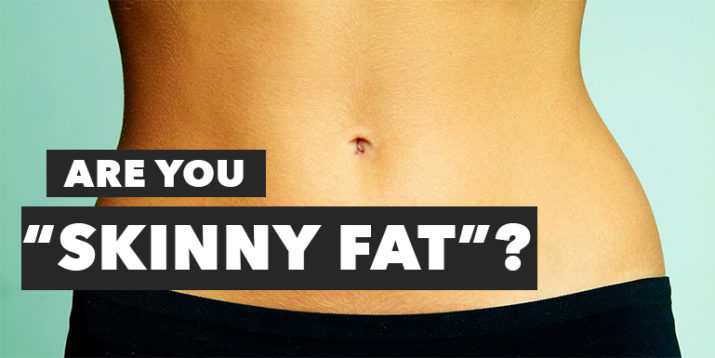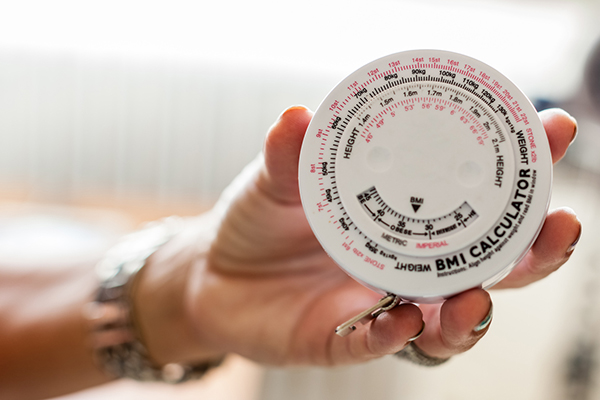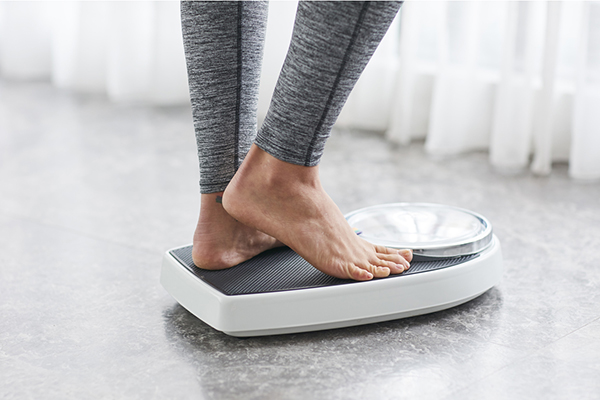How to Tell If You’re Skinny Fat

We all have that friend. The one who eats only mac ‘n’ cheese and cookies, performs zero physical activity, yet still fits into jeans from high school. While you sweat through regular workouts and take the time and effort to cook and eat healthy meals, that “skinny fat” guy or girl stays thin seemingly without trying.
But looks can be deceiving. The number on the scale doesn’t paint the whole picture.
What Is Skinny Fat?
“Skinny fat” is an unscientific, nonmedical term that generally refers to people who fall within a healthy weight range but exceed the recommended body fat percentage and do not meet normal ranges for muscle mass.
“The term ‘skinny fat’ is the perfect demonstration of the misconceptions of what being healthy is,” says Cody Braun, CPT.
The medical term for “skinny fat” is metabolically obese normal weight. (And since “skinny fat” isn’t the friendliest of terms, we’ll mostly stick with MONW from here on out.) The acronym says it all: A person can be a seemingly healthy weight yet be metabolically obese.
An estimated 20 percent of the general population falls under the MONW umbrella, and researchers admit we need to better understand what causes it, how to identify it, and how to treat it.
Risks of Being Metabolically Obese Normal Weight (MONW)
MONW individuals typically have increased levels of insulin resistance, which is when muscle, liver, and fat cells stop responding normally to insulin, preventing the absorption of glucose from the bloodstream and necessitating higher levels of insulin.
Research suggests people who are MONW have a higher risk of developing diabetes, cardiovascular disease, and mortality. And while the connection isn’t yet clear, some studies suggest those in the MONW category are more often vitamin D deficient than people who are metabolically healthy.
“Weight isn’t necessarily a good indication of health,” Benté says. “You can be of a higher weight, but if you’re working out and you’re eating well, you may be metabolically healthy. On the other hand, you can look healthy on the outside, or ‘thin,’ but your weight may not show a true picture of what’s going on inside.”
Because MONW people can appear healthy (or healthier than those who are overweight), serious health concerns may go overlooked. Someone who falls into the normal weight range may delay health interventions that could increase the chances for a long, healthy life.
“Many people may be unaware of their increased risk of developing metabolic abnormalities, despite their normal BMI,” says Rishi Caleyachetty, PhD., of the Institute of Applied Health Research, at the University of Birmingham in England.
That brings us to BMI and its role in measuring health.
Is BMI an Accurate Measure of Health?

While body mass index is frequently used to determine healthy body weight, it’s definitely not foolproof. The biggest problem: It doesn’t account for a person’s fat-to-muscle ratio.
Take a bodybuilder like Phil Heath, for instance. At five foot nine and roughly 250 pounds during competition season, his BMI is 36.9, which is considered obese. But take one look at Heath — with nearly every superficial muscle clearly visible and no excess fat — and you’ll see he’s anything but obese. Heath’s stats go to show that BMI does not always deliver an accurate snapshot of health.
“BMI is calculated using height and weight only, so it’s deceiving,” Benté says. “It does not take into account gender, age, or body fat percentage. Because someone is thin and physically takes up less space in the universe than someone else doesn’t mean they’re healthy,” she says.
Just as there are underweight and normal-weight people who are metabolically unhealthy (you know, MONW), there are overweight individuals who are metabolically healthy.
Studies suggest you can be obese and metabolically healthy at the same time, which is known as metabolically healthy but obese. So how do you know where you stand? How can you tell if you’re “skinny fat?”
How to Tell If You’re Skinny Fat

Many MONW individuals typically carry more fat around their belly, don’t exercise, and generally proceed as if they can eat whatever they want without gaining weight, including processed foods high in sugar and fat.
“It doesn’t matter if your metabolism is super high and you magically never gain weight,” says Paige Benté, M.S., R.D., C.S.S.D. “If you never work out and you eat a bunch of crappy food, you should probably make a change.” And if you have the upper-body strength of a newborn kitten and get winded walking up a single flight of stairs, you may also be metabolically unhealthy.
Beyond assessing your behavior, there are tests that can give you a better idea where you fall on the metabolic obesity scale. One study found that the tryglyceride-glucose index, which is considered “the gold standard” for measuring insulin sensitivity, is a useful way to determine whether or not you’re MONW.
DEXA scans (also called dual-energy X-ray absorptiometry) are another option. While often used to measure bone density, the 15-minute test also takes a comprehensive look at body fat and muscle mass. Additionally, DEXA scans identify where body fat is distributed, which can help alert doctors to certain health risks.
For instance, more fat surrounding the internal organs — known as visceral fat — has been linked to an increased risk for a number of diseases, including heart disease, hypertension, and type 2 diabetes.
If you’re more of a numbers person, DEXA scans are a fairly easy way to get a better handle on your body composition and body fat percentage. But keep this in mind: “There is no general agreement on what defines excess fat when using an estimation of body fat percentage,” Caleyachetty says.
The good news: If you choose the DEXA scan route, you can keep track of your body fat percentage as you lose weight or make changes to your lifestyle.
Once you have a handle on whether or not you fall into the MONW camp (or if you’re unsure, but ready to make changes), it’s time to ease into the fit life.
7 Tips to Lose Fat and Get Healthy and Strong

How do you get strong and healthy? “Follow smart, calculated, sustainable nutrition programs paired with a healthy mix of cardio and strength training,” Braun says. And make sure to take things one step at a time to make healthy, sustainable lifestyle changes.
1. Talk to the pros
“People need to seek support from the appropriate health professional regarding advice on and treatment with diet, exercise, and possibly pharmacological therapies,” Caleyachetty says. Don’t hesitate to talk your healthcare provider for advice, guidance, and moral support.
2. Move more
The Centers for Disease Control and Prevention (CDC) recommends that adults do strength training and 150 minutes of moderate activity or 75 minutes of vigorous exercise a week.
But if you’re a fitness newbie, you don’t have to sign up for a triathlon the minute you plan on getting healthier. Get started by simply building more movement into your day: Walk while you’re on the phone, take the stairs, park farther away, stand while folding your laundry — do whatever you can to get up and moving more often.
Once you get into the rhythm of getting more daily activity, build on that by incorporating challenging, regular workouts.
Remember: Being more active every single day — and making it part of your lifestyle — is key to long-term weight loss and optimal health.
3. Do strength training + cardio workouts
Doing cardio alone isn’t the best route to sustained weight loss. Cardio can burn major calories during a workout, but cardio and strength training will help you build muscle and ramp up your metabolism so that you’re still burning calories even after your workout.
Interval training merges benefits from both cardio and strength. “The most efficient way to burn fat and build muscle simultaneously is to do something along the lines of HIIT training,” Braun says, with programs such as CORE DE FORCE.
4. Add healthy eating habits one at a time
Make it a goal to start eating healthy, but go slow. Making small, gradual changes — rather than trying to cut all your bad habits, cold-turkey — can help you stick with the program. For instance, if you’re not really a veggie lover, simply try adding one serving of vegetables each day, Benté suggests. And rather than counting every calorie, focus on portion control instead.
5. Prioritize protein
Your body needs protein to build, repair, and maintain muscle, and when you’re embarking on a new fitness journey, your protein needs will probably increase. Lean meats, poultry, fish, beans, tofu, Shakeology, eggs, and yogurt are all great protein sources.
6. Limit alcohol
When you’re in the process of getting healthier, alcohol can really get in the way. We’re not saying you can’t have a drink or two here and there (thank, goodness), but booze adds tons of calories to your day and can also stimulate your appetite and lower your inhibitions — meaning you may reach for pizza and chips when you get home from the bar.
7. Pass on processed food
Stick with whole foods that don’t come in a box or a bag. Processed foods often include added sugars, preservatives, salt, and other artificial additives that can promote weight gain.
The Bottom Line
Getting healthy isn’t just about a certain number on the scale. “This is for your longevity,” says Benté.
